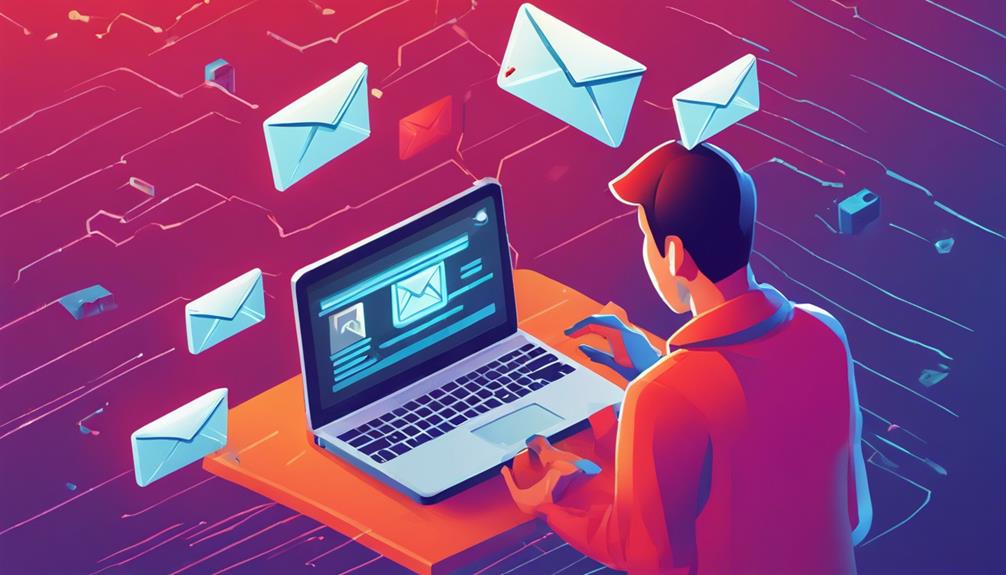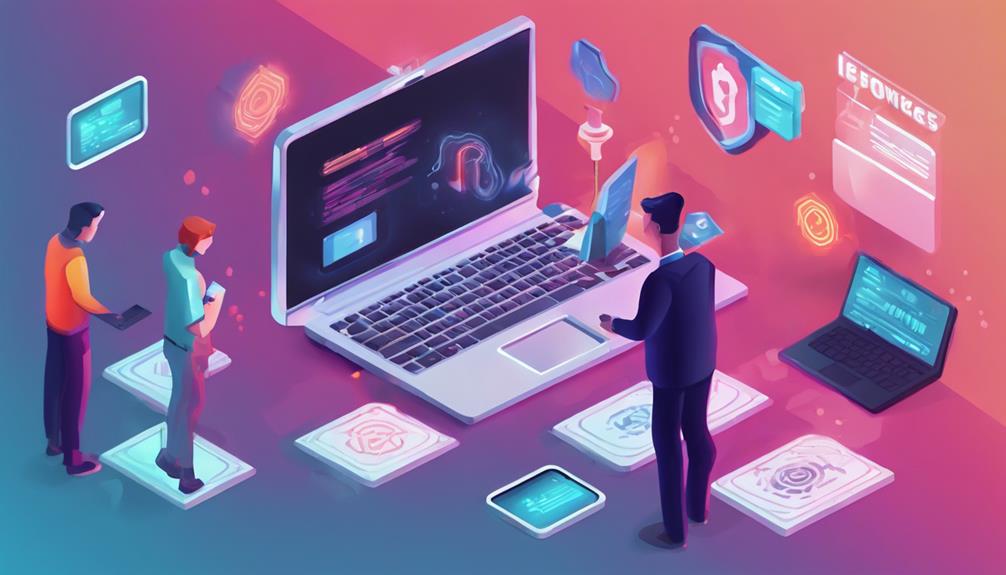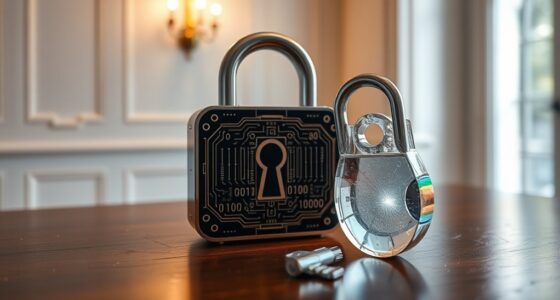Protecting your online security involves more than just strong passwords. Common blunders, such as weak password practices and falling for phishing scams, can expose your data. Ignoring software updates and sharing sensitive information online also pose risks. Using public Wi-Fi without protection, not implementing multi-factor authentication, and neglecting data backups are additional vulnerabilities. Disregarding security alerts can lead to unauthorized access. Learning how to address these blunders is important for safeguarding your information. Find out more about these security mistakes to enhance your online safety and protect your valuable data.
Key Takeaways
- Weak passwords and password reuse are common security blunders.
- Falling for phishing scams compromises personal information.
- Ignoring software updates exposes devices to cyber threats.
- Sharing sensitive information online increases the risk of identity theft.
- Using public Wi-Fi without caution poses security risks.
Weak Password Practices
Weak password practices pose a significant threat to online security, with 81% of data breaches attributed to the use of easily guessable or reused passwords. Using weak passwords not only jeopardizes personal security but also compromises the privacy of sensitive information stored online.
Reusing passwords across multiple accounts further exacerbates this issue, as it provides cybercriminals with easier access to a plethora of digital assets. To combat this vulnerability, tools like Google Password Manager can be utilized to generate and store unique passwords for each online account, reducing the risk of unauthorized access and potential data breaches.
Falling for Phishing Scams

Prioritizing online security is crucial for individuals and businesses alike, especially in the face of phishing scams, which make up 90% of cyberattacks.
Cybercriminals frequently utilize phishing emails to trick unsuspecting targets into divulging personal information or clicking on malicious links. These fraudulent emails often masquerade as legitimate sources, such as trusted banks or government agencies. Once a recipient falls victim to the scam, their sensitive data like passwords, credit card details, or social security numbers can be compromised.
Remaining cautious when receiving unsolicited emails that request personal information is important in thwarting phishing attempts. Recognizing potential phishing attacks requires vigilance, as cybercriminals commonly use urgency or fear tactics to manipulate their victims.
Ignoring Software Updates

Consistently updating your software is essential to patch vulnerabilities and protect your devices from emerging threats. Ignoring software updates can leave your systems exposed to cyber attacks, compromising sensitive data.
Essential security patches are often included in these updates to enhance protection against potential breaches.
Update Software Regularly
Consistent software updates are imperative for maintaining robust cybersecurity measures and safeguarding digital assets from potential security breaches. Regular software updates typically include security patches designed to address known vulnerabilities in the system. Updates often contain essential fixes that can prevent cybercriminals from exploiting weaknesses in the software, reducing the risk of malware infections and system compromise.
By ignoring updates, individuals leave their devices susceptible to attacks that take advantage of known security flaws. Cybercriminals frequently target outdated software as it provides an easy entry point into systems for carrying out malicious activities. Timely software updates play a critical role in addressing security issues promptly and protecting sensitive data from exploitation.
To emphasize the importance of regular software updates, let's examine the following table showcasing the impact of ignoring updates:
| Consequences of Ignoring Updates |
|---|
| Increased risk of cyberattacks exploiting known vulnerabilities |
| Higher likelihood of malware infections and system compromise |
| Easy entry points for cybercriminals targeting outdated software |
| Failure to address security issues promptly, leading to data exploitation |
Vulnerabilities in Old Software
Neglecting to update software regularly poses a significant risk to cybersecurity, especially when it comes to the vulnerabilities present in outdated systems. Delaying software updates can expose devices to cyberattacks that exploit known security flaws.
Approximately 80% of successful cyberattacks involve vulnerabilities that could have been prevented by timely updates. By overlooking software updates, individuals increase the likelihood of malware infections targeting their systems. These infections can compromise sensitive data stored on the device, leading to potential breaches and data leaks.
Ignoring the importance of software updates leaves devices susceptible to exploitation by cybercriminals who actively seek out outdated systems for easy access. It is essential to prioritize regular software updates to make sure that security flaws are addressed promptly, reducing the risk of falling victim to cyber threats that exploit vulnerabilities in old software.
Security Patches Essential
Failing to prioritize software updates can leave your devices vulnerable to cyberattacks that exploit known security flaws. Regular software updates contain essential security patches that protect devices and data from emerging threats.
Delaying these updates increases the risk of falling victim to cyberattacks that target vulnerabilities in outdated software. Both Android and ChromeOS offer automatic system updates to guarantee timely delivery of security patches, minimizing the window of opportunity for potential attacks.
Moreover, timely software updates play a vital role in preventing application crashes and maintaining the functionality of your devices. Ignoring these updates not only leaves your devices exposed to cyber threats but also increases the likelihood of experiencing disruptions such as application crashes.
Sharing Sensitive Information Online

Sharing sensitive information online, such as birthdates and vacation plans, can put individuals at risk of identity theft and burglary. Additionally, oversharing personal details on social media platforms increases the likelihood of encountering scams or phishing attempts.
It is essential to be cautious about what information is shared online to protect oneself from potential security breaches and privacy invasions.
Privacy on Social Media
Maintaining privacy on social media platforms poses a significant challenge due to the continuous collection and potential exposure of sensitive information, even when privacy settings are adjusted. Despite efforts to control what is shared, social media platforms persist in gathering data for targeted advertising and other purposes, raising the risk of privacy violations.
Data breaches are a common consequence of sharing sensitive information online, leaving individuals vulnerable to identity theft and unauthorized access to personal details. While privacy settings offer some level of control over shared data, they do not provide vital protection against potential risks.
It is important for users to be cautious about the information they share online to safeguard their online presence and personal information. By being mindful of the content shared, individuals can protect themselves from privacy breaches and data leaks, preserving their professional and personal reputation in the digital domain.
Risks of Public Wi-Fi
The vulnerability of public Wi-Fi networks to cyberattacks poses a significant risk to individuals sharing sensitive information online. Public Wi-Fi often lacks encryption, making data transmission insecure and easily accessible to hackers.
When connecting to unsecured networks, sensitive information such as passwords and financial data are at risk of interception, potentially leading to identity theft. To mitigate these risks, utilizing Virtual Private Networks (VPNs) on public Wi-Fi can add a layer of encryption, safeguarding online activities from prying eyes.
- Hackers' Playground: Public Wi-Fi networks are prime targets for cybercriminals due to their lack of encryption, allowing easy interception of sensitive data.
- VPN Shield: Using a VPN on public Wi-Fi encrypts data transmissions, reducing the risk of unauthorized access to personal information.
- Rogue Networks: Cybercriminals may set up fake Wi-Fi networks to trick users into connecting, enabling them to steal data and compromise security.
Using Public Wi-Fi Unprotected

When connecting to public Wi-Fi networks, users must exercise caution to protect their sensitive information from potential cyber threats. Public Wi-Fi poses security risks as hackers can easily intercept data transmitted over these networks, leading to data breaches and identity theft.
Using unprotected public Wi-Fi exposes individuals to malware infections, financial fraud, and unauthorized access to personal information. Cybercriminals often create fake Wi-Fi hotspots to lure unsuspecting users into connecting and stealing their sensitive data.
To safeguard against these threats, it is essential to encrypt data when using public Wi-Fi. One effective method is by utilizing a Virtual Private Network (VPN) which creates a secure connection and encrypts the information being transmitted. This encryption helps in preventing cyberattacks and maintaining privacy while browsing on public Wi-Fi networks.
Lack of Multi-Factor Authentication

Implementing multi-factor authentication is an essential step in enhancing online security and protecting sensitive information against unauthorized access.
Multi-factor authentication (MFA) adds an extra security layer beyond passwords by requiring a combination of factors such as something you know (password), something you have (phone), and something you are (biometric). This method greatly reduces the risk of unauthorized access to accounts, as 80% of data breaches involve weak or stolen credentials.
By incorporating MFA, individuals can enhance online security and better protect their sensitive information from cyber threats. It is a straightforward yet effective way to safeguard online accounts and prevent unauthorized individuals from gaining access.
It is vital for individuals to prioritize implementing multi-factor authentication across their online accounts to reduce the likelihood of falling victim to cyberattacks.
Not Backing Up Data Regularly

Regularly backing up data is an essential practice in safeguarding against potential data loss incidents. Data loss can occur due to various reasons such as hardware failures, cyberattacks, or accidental deletion.
Surprisingly, 30% of people have never backed up their data, leaving them vulnerable to losing important information. Backups play an important role in protecting against ransomware attacks and data corruption.
Utilizing cloud storage solutions offers a convenient and secure backup option, guaranteeing that your data is safe even if your physical devices fail. It is advisable to create multiple backups to establish data redundancy and better safeguard your information.
Disregarding Security Alerts

Failing to heed security alerts poses a significant risk to individuals and organizations alike, potentially exposing them to cyber threats and vulnerabilities. Dismissing these warnings as false alarms can lead to serious consequences, including unauthorized access to personal information, financial loss, and increased susceptibility to cyber threats.
It is vital to recognize that security alerts are designed to protect against potential threats and vulnerabilities by detecting suspicious activities and preventing data breaches. Ignoring these notifications can have detrimental effects on online safety and privacy, making it essential to take immediate action upon receiving them.
Frequently Asked Questions
What Are the Common Mishaps on Online Safety and Security?
Common mishaps on online safety and security include using the same password everywhere, neglecting software updates, overlooking 2-Step Verification, not setting a screen lock PIN on mobile devices, and clicking on suspicious links, which can lead to data breaches and cyberattacks.
What Are the 5 Internet Safety Rules?
Internet safety rules include avoiding sharing personal information online, being cautious of unknown links or downloads, regularly updating passwords, using secure Wi-Fi networks, and staying vigilant for phishing scams. These practices enhance online security and protect against cyber threats.
What Is 1 Example on Being Safe Online?
Enhancing online safety can be symbolized by setting up 2-Step Verification. This adds an additional layer of security to your accounts. By adopting this practice, you can greatly reduce the risk of unauthorized access and protect your online presence.
How to Stay Safe Online a Guide for Everyone Who Uses the Internet?
To stay safe online, implement strong passwords, enable multi-factor authentication, and remain vigilant against social engineering tactics like phishing. Regularly update antivirus software, educate on malware threats, secure APIs with authentication mechanisms, and monitor for suspicious activity.
Conclusion
In essence, safeguarding your online presence is vital to prevent security breaches. By avoiding weak passwords, falling for phishing scams, and ignoring updates, individuals can enhance their online safety. Remember to utilize multi-factor authentication, back up data regularly, and stay vigilant against security alerts.
Stay secure online by making smart choices and staying informed.









